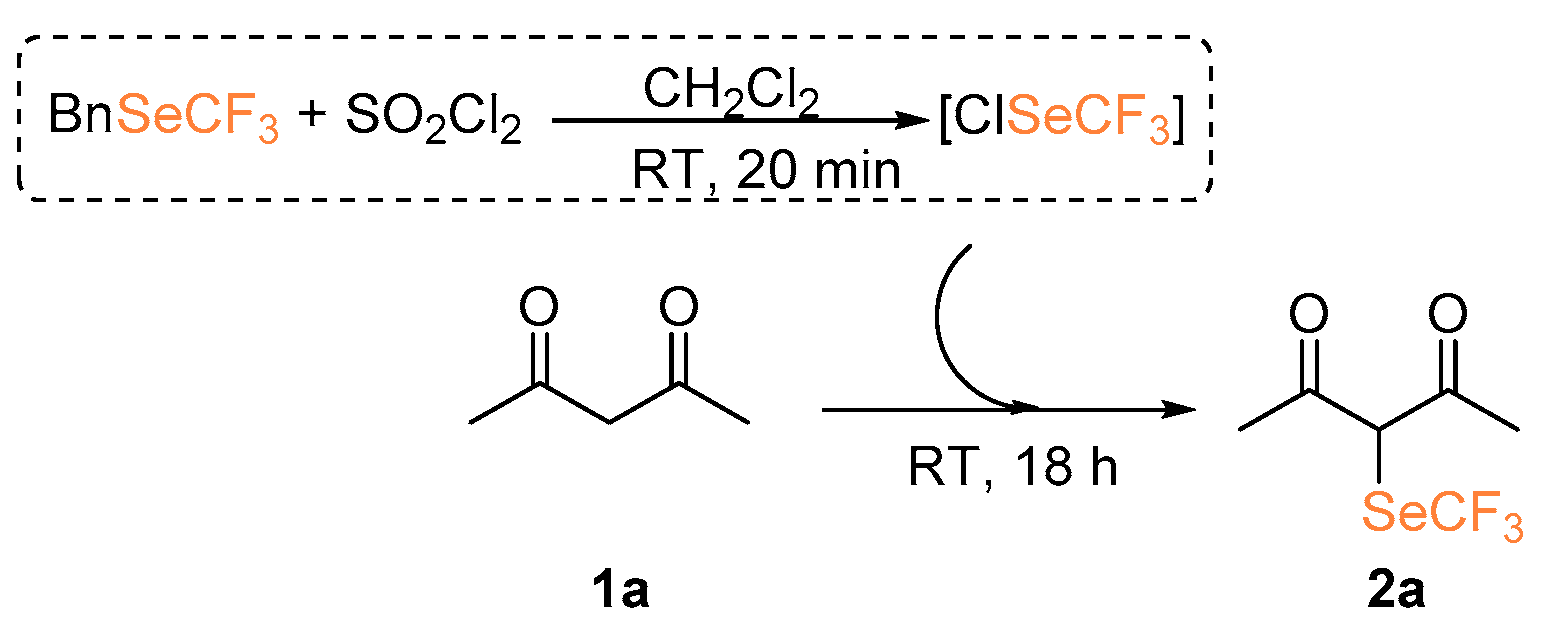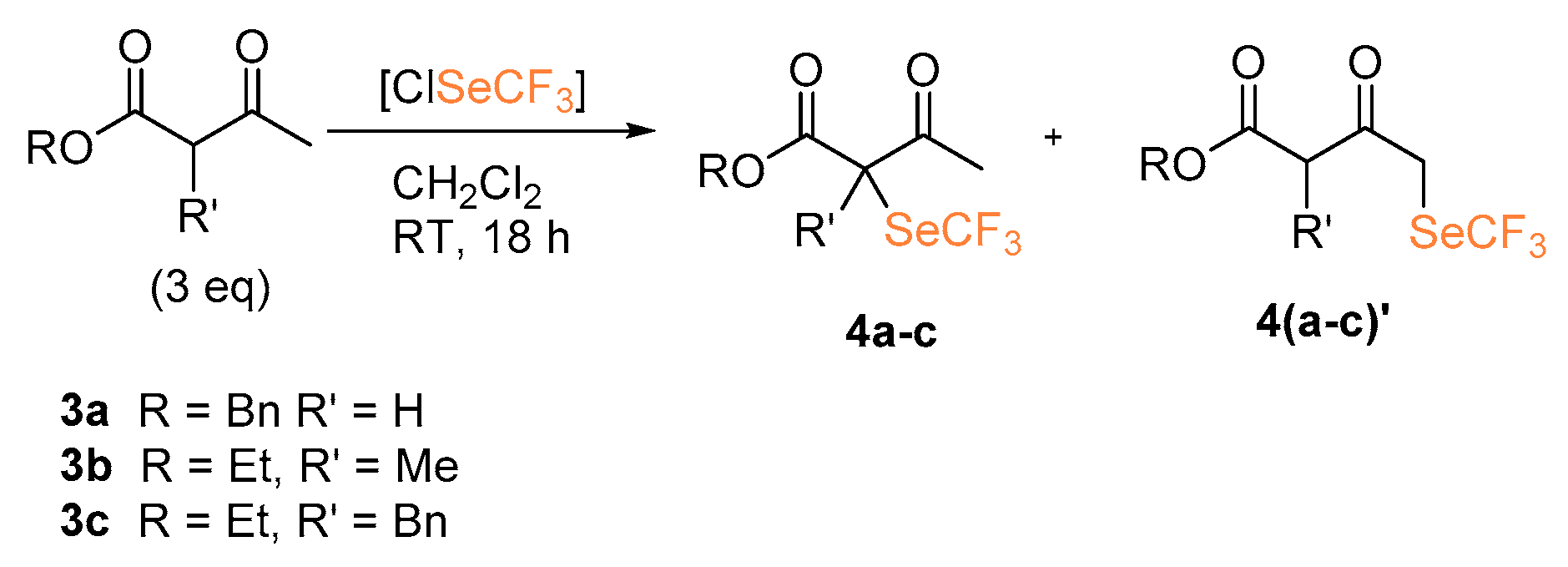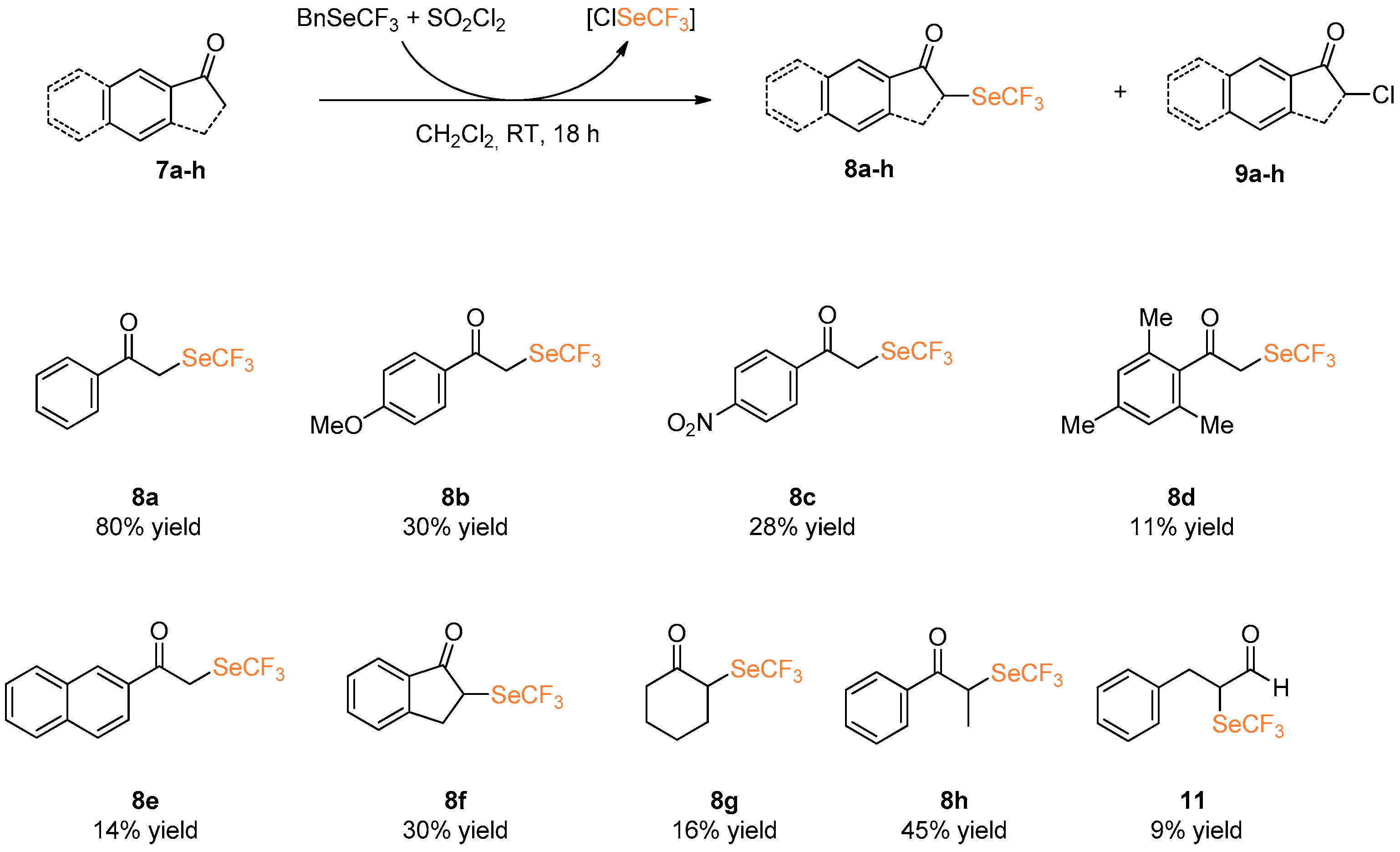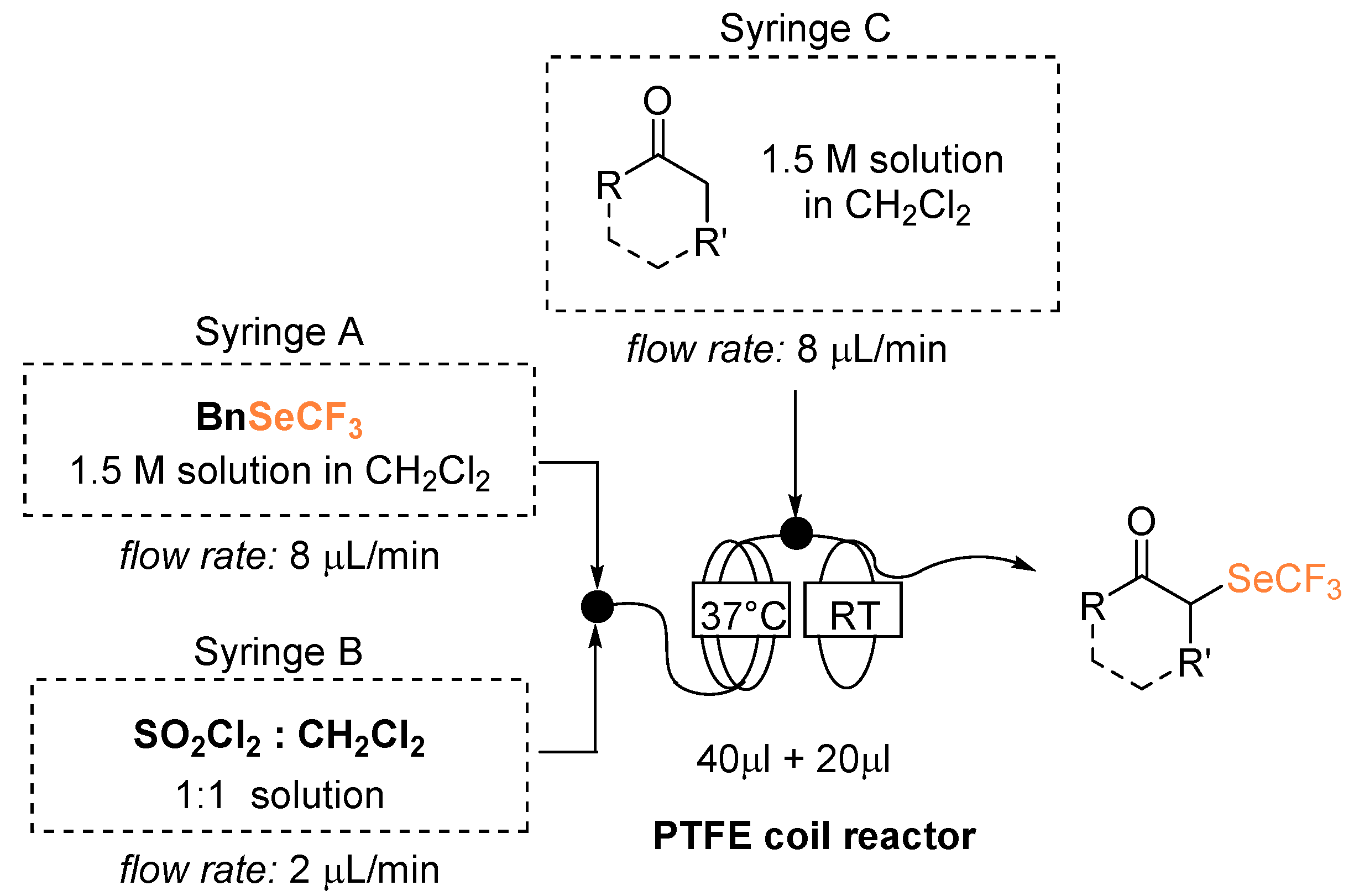Metal-Free Alpha Trifluoromethylselenolation of Carbonyl Derivatives under Batch and Flow Conditions
Abstract
:1. Introduction
2. Results and Discussion
3. Materials and Methods
3.1. General Procedure for the Metal-Free α-Trifluoromethylselenolation of Carbonyl Derivatives under Batch Conditions
3.2. General Procedure for the Metal-Free α-Trifluoromethylselenolation of Carbonyl Derivatives under Flow Conditions
4. Conclusions
Supplementary Materials
Author Contributions
Funding
Acknowledgments
Conflicts of Interest
References and Notes
- Carland, M.; Fenner, T. 34Se The Use of Selenium-Based Drugs in Medicine. In Metallotherapeutic Drugs and Metal-Based Diagnostic Agents: The Use of Metals in Medicine; Gielen, M., Tiekink, E.R.T., Eds.; Wiley: Hoboken, NJ, USA, 2005; pp. 313–332. [Google Scholar]
- Schewe, T. Molecular actions of ebselen--an antiinflammatory antioxidant. Gen. Pharmacol. 1995, 26, 1153–1169. [Google Scholar] [CrossRef]
- Singh, N.; Sharpley, A.L.; Emir, U.E.; Masaki, C.; Herzallah, M.M.; Gluck, M.A.; Sharp, T.; Harmer, C.J.; Vasudevan, S.R.; Cowen, P.J.; et al. Effect of the Putative Lithium Mimetic Ebselen on Brain Myo-Inositol, Sleep, and Emotional Processing in Humans. Neuropsychopharmacology 2015, 41, 1768. [Google Scholar] [CrossRef] [PubMed]
- Romashov, L.V.; Ananikov, V.P. Self-Assembled Selenium Monolayers: From Nanotechnology to Materials Science and Adaptive Catalysis. Chem. Eur. J. 2013, 19, 17640–17660. [Google Scholar] [CrossRef] [PubMed]
- Braga, A.; Lüdtke, D.; Vargas, F.; Braga, R. Catalytic Applications of Chiral Organoselenium Compounds in Asymmetric Synthesis. Synlett 2006, 2006, 1453–1466. [Google Scholar] [CrossRef]
- Luo, J.; Zhu, Z.; Liu, Y.; Zhao, X. Diaryl Selenide Catalyzed Vicinal Trifluoromethylthioamination of Alkenes. Org. Lett. 2015, 17, 3620–3623. [Google Scholar] [CrossRef] [PubMed]
- Li, M.; Guo, J.; Xue, X.S.; Cheng, J.P. Quantitative Scale for the Trifluoromethylthio Cation-Donating Ability of Electrophilic Trifluoromethylthiolating Reagents. Org. Lett. 2016, 18, 264–267. [Google Scholar] [CrossRef] [PubMed]
- Tlili, A.; Ismalaj, E.; Glenadel, Q.; Ghiazza, C.; Billard, T. Synthetic Approaches to Trifluoromethylselenolated Compounds. Chem. Eur. J. 2018, 24, 3659–3670. [Google Scholar] [CrossRef] [PubMed]
- Zhang, C.J. Recent Progress Toward Trifluoromethylselenolation Reactions. Chin. Chem. Soc. 2017, 64, 457–463. [Google Scholar]
- Dale, J.W.; Emeleus, H.J.; Haszeldine, R.N. Organometallic and organometalloidal fluorine compounds. Part XIV. Trifluoromethyl derivatives of selenium. J. Chem. Soc. 1958, 2939. [Google Scholar] [CrossRef]
- Yarovenko, N.N.; Shemanina, V.N.; Gazieva, G.B. Electrophilic trifluoromethylselenolation of terminal alkynes with Se-(trifluoromethyl)-4-methylbenzenesulfonoselenoate. Russ. J. Gen. Chem. 1959, 29, 924–927. [Google Scholar]
- Magnier, E.; Wakselman, C. A Mild and Practical Preparation of Trifluoromethaneselenenyl Chloride. Collect. Czech. Chem. Commun. 2002, 67, 1262–1266. [Google Scholar] [CrossRef]
- Glenadel, Q.; Ismalaj, E.; Billard, T. Benzyltrifluoromethyl (or Fluoroalkyl) Selenide: Reagent for Electrophilic Trifluoromethyl (or Fluoroalkyl) Selenolation. J. Org. Chem. 2016, 81, 8268–8275. [Google Scholar] [CrossRef] [PubMed]
- Dong, T.; He, J.; Li, Z.-H.; Zhang, C.-P. Catalyst- and Additive-Free Trifluoromethylselenolation with [Me4N][SeCF3]. ACS Sustain. Chem. Eng. 2018, 6, 1327–1335. [Google Scholar] [CrossRef]
- Yang, Y.; Xia, L.; Zheng, Z.; Lin, G.; Zhang, Y.; You, Y.; Weng, Z.J. α-Trifluoromethylseleno-substituted ketones synthesis via copper-mediated trifluoromethylselenolation of α-bromoketones. Fluor Chem. 2017, 204, 1–5. [Google Scholar] [CrossRef]
- Glenadel, Q.; Ismalaj, E.; Billard, T. Electrophilic Trifluoromethyl- and Fluoroalkylselenolation of Organometallic Reagents. Eur. J. Org. Chem. 2017, 530–533. [Google Scholar] [CrossRef]
- Denmark, S.E.; Rossi, S.; Webster, M.P.; Wang, H.J. Catalytic, Enantioselective Sulfenylation of Ketone-Derived Enoxysilanes. J. Am. Chem. Soc. 2014, 136, 13016–13028. [Google Scholar] [CrossRef] [PubMed]
- Abubakar, S.S.; Benaglia, M.; Rossi, S.; Annunziata, R. Organocatalytic α-trifluoromethylthiolation of silylenol ethers: Batch vs continuous flow reactions. Catal. Today 2018, 308, 94–101. [Google Scholar] [CrossRef]
- Rossi, S.; Puglisi, A.; Raimondi, L.; Benaglia, M. Synthesis of Alpha-trifluoromethylthio Carbonyl Compounds: A Survey of the Methods for the Direct Introduction of the SCF3 Group on to Organic Molecules. ChemCatChem 2018. [Google Scholar] [CrossRef]
- The Billard group demonstrated already that such reaction could be performed and, independently from ours, simultaneously developed the α-trifluoromethylselenolation of ketones: Ghiazza, C.; Tlili, A.; Billard, T.; Direct α-C–H Trifluoromethylselenolation of Carbonyl Compounds. Eur. J. Org. Chem. 2018, 3680–3683.
- In the 19F NMR spectra of the crudes, few interesting peaks are present which could be potentially attributed to the desired compound, as their chemical shifts were compatible with those one could expected for trifuoromethylfunctionalized ketones based on the data we obtained in the previous experiments. We subjected the crude to purification via column chromatography, but disappointingly, we could not isolate any product. Further investigations would be needed to confirm this unexpected result.
- The amounts of unreacted substrates, isolated products and chlorinated by-products collected were too low to account for the quantities of starting material employed These hard-to-rationalize results suggest that side reactions, leading to degradation, take place.
- Polyisocyanurate (PIC) ferrule and zero-dead connections were employed for convenience.
- An intense work of optimization has been performed, working with different stoichiometry of the reagents and different concentrations, but only marginal improvements of the yields were obtained in the case of ketones 7b and 7c, the best results being reported in Table 2.
- An extensive experimental work has been done in the attempt to further improve the reaction yields; however, the use of higher concentrations of ketones was hampered by low solubility of the reagents, a crucial issue incompatible with the continuous-flow reactor set up. On the other hand, when an excess when an excess of BnSeCF3 and SO2Cl2 to generate ClSeCF3 was employed, the formation of significant amounts of side products, such as chlorinated derivatives, was observed, rather than an increase of the desired product yield.
Sample Availability: Samples of the compounds are available from the authors. |






| Entry | Reagent | Desired Product |
|---|---|---|
| 1 |  1b |  2b |
| 2 |  1c |  2c |
| 3 |  1d |  2d |
| Entry | Substrate | 19F-NMR Conversion (%) 1 |
|---|---|---|
| 1 | 3a | 44 |
| 2 | 7a | 70 |
| 3 2 | 7b | 41 |
| 4 2 | 7c | 23 |
| 5 | 7g | 80 |
| 6 3 | 7h | 70 |
© 2019 by the authors. Licensee MDPI, Basel, Switzerland. This article is an open access article distributed under the terms and conditions of the Creative Commons Attribution (CC BY) license (http://creativecommons.org/licenses/by/4.0/).
Share and Cite
Massolo, E.; Pirola, M.; Rossi, S.; Benincori, T. Metal-Free Alpha Trifluoromethylselenolation of Carbonyl Derivatives under Batch and Flow Conditions. Molecules 2019, 24, 726. https://doi.org/10.3390/molecules24040726
Massolo E, Pirola M, Rossi S, Benincori T. Metal-Free Alpha Trifluoromethylselenolation of Carbonyl Derivatives under Batch and Flow Conditions. Molecules. 2019; 24(4):726. https://doi.org/10.3390/molecules24040726
Chicago/Turabian StyleMassolo, Elisabetta, Margherita Pirola, Sergio Rossi, and Tiziana Benincori. 2019. "Metal-Free Alpha Trifluoromethylselenolation of Carbonyl Derivatives under Batch and Flow Conditions" Molecules 24, no. 4: 726. https://doi.org/10.3390/molecules24040726
APA StyleMassolo, E., Pirola, M., Rossi, S., & Benincori, T. (2019). Metal-Free Alpha Trifluoromethylselenolation of Carbonyl Derivatives under Batch and Flow Conditions. Molecules, 24(4), 726. https://doi.org/10.3390/molecules24040726








